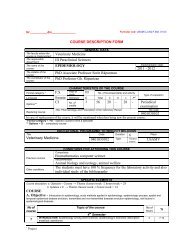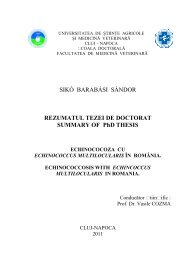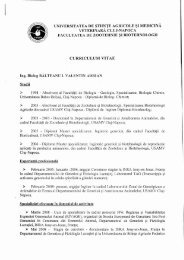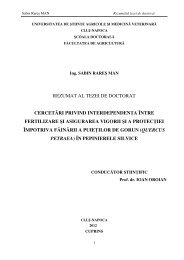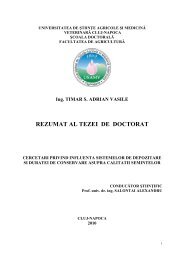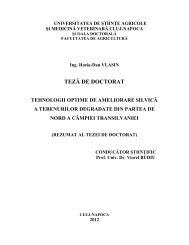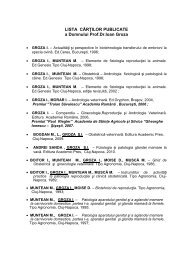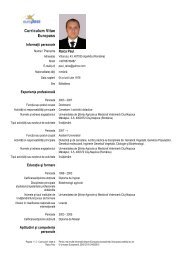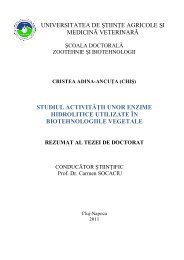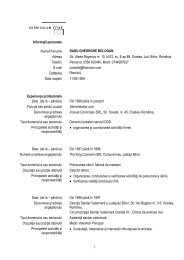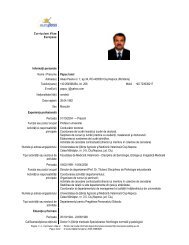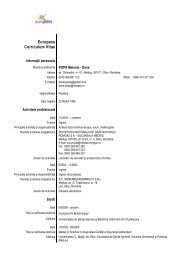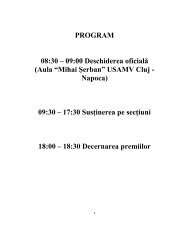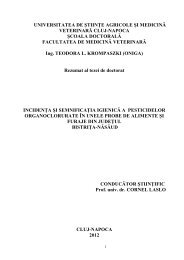self evaluation report - Universitatea de Ştiinţe Agricole şi Medicină ...
self evaluation report - Universitatea de Ştiinţe Agricole şi Medicină ...
self evaluation report - Universitatea de Ştiinţe Agricole şi Medicină ...
You also want an ePaper? Increase the reach of your titles
YUMPU automatically turns print PDFs into web optimized ePapers that Google loves.
The University of Agricultural Sciences and Veterinary Medicine Cluj-Napoca main campus, of about 16<br />
hectares, is situated in the west part of the city, including a 6 hectares park and a botanical gar<strong>de</strong>n. The second<br />
campus, for food science, is close to the central one, making the university one of the most compact campuses<br />
in the area. The university owns more than 1.000 hectares of land for teaching and experimental research, and<br />
stu<strong>de</strong>nts practice, organized in a Teaching and experimental research Station, with four locations within Cluj<br />
neighborhood, where more than 1,000 stu<strong>de</strong>nts practice 10 months out of a year.<br />
Being situated in the central part of Transylvania (85.000 km 2 ) and the only agricultural university in this area,<br />
the university receives most of its stu<strong>de</strong>nts (78%) from this important agricultural region. The rest of the<br />
stu<strong>de</strong>nts are coming from the other parts of the country, being attracted by the quality of the studies and the<br />
city opportunities.<br />
2.4. Current regional and national labor market situation<br />
The Romanian labor market has changed significantly since the 90’s, being strongly affected by the transition<br />
to the market economy, EU membership, the reduction of the heavy industry and the existing centralized<br />
agricultural system. Despite all these inconveniences Cluj county is nowadays one of the most dynamic region<br />
of Romania, having a major contribution to the economic <strong>de</strong>velopment, mainly due of its highly qualified<br />
human resources. Cluj-Napoca, a university City with four universities ranked within the first class of<br />
“advanced research and education”, has a low unemployment rate, of less than 2%, offering for the local<br />
agriculture and the private sector new job opportunities. We need to consi<strong>de</strong>r that agriculture, even with the<br />
dramatically reduction of the agricultural population, from 42% in the 90’s to 31% nowadays and probably<br />
15% in 2025, will remain important for Romania. It has to be un<strong>de</strong>rlined that one third of our stu<strong>de</strong>nts families<br />
own agricultural land.<br />
2.5. Structure, stu<strong>de</strong>nts and staff<br />
USAMV Cluj-Napoca is using for more than ten years the Bologna system, with a particular BSc of four years<br />
(4+2+3). The 1 st and 2 nd study cycles are organized as full-time or long distance/reduced frequency (part-time)<br />
study programs, by the four faculties. The 3 rd study cycle (PhD), as well as post-doctoral studies, is organized<br />
by an Interdisciplinary Doctoral School, with five specializations of full-time study. As a research university, the<br />
MS and PhD activities are completed within 23 research centers and laboratories, as well as 3 Research<br />
Institutes (The Life Sciences and other two un<strong>de</strong>r construction).<br />
The structure of the university is <strong>de</strong>signated to fit the activity for the un<strong>de</strong>rgraduate studies (BSc), the<br />
graduate studies (MS) and the postgraduate studies (PhD and post-doc). The university’s infrastructure was<br />
completely renewed in the last 4 years, offering a lot of opportunities and facilities for stu<strong>de</strong>nts and staff, and<br />
will inclu<strong>de</strong> in the near future, a new library, a new stu<strong>de</strong>nt resi<strong>de</strong>nce, a stu<strong>de</strong>nts’ restaurant and other<br />
<strong>de</strong>velopments that will make the university more attractive and a<strong>de</strong>quate for a capacity of about 7.000<br />
stu<strong>de</strong>nts.<br />
USAMV Cluj-Napoca inclu<strong>de</strong>s 4 faculties: Agriculture, Horticulture, Animal Science and Biotechnology and<br />
Veterinary Medicine. The university’s stu<strong>de</strong>nts (the 1 st , 2 nd and 3 rd study cycle) are enrolled into the faculties as<br />
follows: 2,166 in Horticulture, 1,882 in Agriculture, 1,427 in Veterinary Medicine, and 745 in Animal Sciences<br />
and Biotechnology. The current number of USAMV Cluj-Napoca registered stu<strong>de</strong>nts is of 6,220 stu<strong>de</strong>nts out of<br />
which 4,869 are enrolled in the bachelor studies, 1,001 are master stu<strong>de</strong>nts and 350 are doctorate stu<strong>de</strong>nts.<br />
Also, 30 young researchers are enrolled in postdoctoral studies (see: Appendix – Stu<strong>de</strong>nts). The number of<br />
stu<strong>de</strong>nts during the last years was of about 6,400 stu<strong>de</strong>nts and we estimate that as a result of the new “A”<br />
classification the university will keep this rate in the following five years.<br />
As a result of a good university’s strategy and the adaptation to the market requirements, the number of<br />
stu<strong>de</strong>nts increased during the past 20 years from 1,720 in 1990, to 3,850 in 2000 and 6,220 in 2011. We<br />
emphasize especially the increase in the number of graduate stu<strong>de</strong>nts in the last five years, from 375 to more<br />
than 1.000 today, and the facts that USAMV Cluj is nowadays the only Romanian agricultural university<br />
qualified for PhD study.<br />
Page 4 SELF-EVALUATION REPORT, March, 2012



